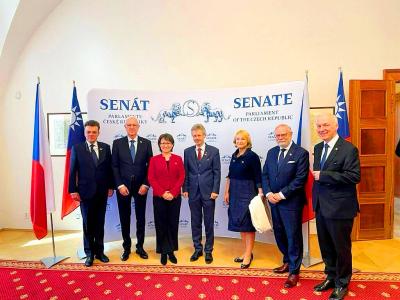The military has concluded a series of simulated cyber warfare maneuvers in which the various branches of the armed forces conducted mock counterattacks on China's coastal military targets following a surprise attack by China, military sources said yesterday.
The round-the-clock five-day computerized warfare simulation, which ended on Friday, was part of the annual "Han Kuang" series of combined services military exercises aimed at honing combat strategies and battlefield management tactics, the sources said.
This year's cyber wargames also marked the first time the armed forces practiced counterattack strategies and skills in simulated warfare drills, the sources said, adding that in the mock counterattacks, Taiwanese troops struck coastal Chinese military targets and booming cities with such weapons as cruise missiles and short-range ballistic missiles.
The military's Joint Operations Command Center, the Joint Operations Training Center and tactical command offices at various strategic military units took part in the computerized maneuvers, the sources said, adding that a US delegation, headed by former Pacific Command commander-in-chief Admiral Dennis Blair, was on hand to observe the process.
The Ministry of National Defense is scheduled to brief the press on the details of the "Han Kuang 23" maneuvers at its routine news conference on Tuesday, the sources said.
Sources also said that the wargame scenario was set in 2012 at a time when China, frustrated by Taiwan's long-term resistance to unification talks, decides to take advantage of Taiwan's procrastination in military arsenal upgrades to accelerate its push for unification by launching an all-out surprise attack on Taiwan proper and its outlying island of Penghu.
In the first three days of the simulated Chinese invasion, Taiwan incurred severe human and material losses from China's saturation ballistic missile assault as well as naval and aerial bombardment.
Afterwards, Taiwan's armed forces managed to stage counterattacks on China's coastal military targets and major cities, causing heavy human casualties and major destruction.
In the scenario, the military strikes had a heavy toll on the economic wellbeing of both sides of the Taiwan Strait and adversely impacted the global economy, causing worldwide panic. In the end, the US and other Western countries mediated a ceasefire.
In a departure from media speculation, however, the wargames did not cover the use of nuclear weapons or Taiwanese attacks on Chinese aircraft carrier battle groups, the sources said.
Meanwhile, the US observation group paid special attention to Taiwanese military personnel's "combat spirit" to determine if morale had been affected by the political infighting that followed the transition of power in 2000.
In weighing the military's "combat spirit," the sources said, the US delegation wanted to determine whether Taiwan would likely lean toward China and whether any advanced US-built weapons systems or sophisticated defense plans would end up in Beijing's hands.
Following the completion of the maneuvers, the military would in initiate a five-day psychological warfare training program aimed at enhancing service members' combat morale, battlefield adaptability and stress management.
The "Han Kuang" series is the largest combined services military exercise in Taiwan. In addition to the computer wargames, it covers live-fire military maneuvers, which will be held later this year.

The Mainland Affairs Council (MAC) today condemned the Chinese Communist Party (CCP) after the Czech officials confirmed that Chinese agents had surveilled Vice President Hsiao Bi-khim (蕭美琴) during her visit to Prague in March last year. Czech Military Intelligence director Petr Bartovsky yesterday said that Chinese operatives had attempted to create the conditions to carry out a demonstrative incident involving Hsiao, going as far as to plan a collision with her car. Hsiao was vice president-elect at the time. The MAC said that it has requested an explanation and demanded a public apology from Beijing. The CCP has repeatedly ignored the desires

Many Chinese spouses required to submit proof of having renounced their Chinese household registration have either completed the process or provided affidavits ahead of the June 30 deadline, the Mainland Affairs Council (MAC) said on Thursday. Of the 12,146 people required to submit the proof, 5,534 had done so as of Wednesday, MAC deputy head and spokesperson Liang Wen-chieh (梁文傑) said. Another 2,572 people who met conditions for exemption or deferral from submitting proof of deregistration — such as those with serious illnesses or injuries — have submitted affidavits instead, he said. “As long as individuals are willing to cooperate with the legal

The Ma-anshan Nuclear Power Plant’s license has expired and it cannot simply be restarted, the Executive Yuan said today, ahead of national debates on the nuclear power referendum. The No. 2 reactor at the Ma-anshan Nuclear Power Plant in Pingtung County was disconnected from the nation’s power grid and completely shut down on May 17, the day its license expired. The government would prioritize people’s safety and conduct necessary evaluations and checks if there is a need to extend the service life of the reactor, Executive Yuan spokeswoman Michelle Lee (李慧芝) told a news conference. Lee said that the referendum would read: “Do

Taiwan's Vice President Hsiao Bi-khim (蕭美琴) said Saturday that she would not be intimidated by the Chinese Communist Party (CCP), following reports that Chinese agents planned to ram her car during a visit to the Czech Republic last year. "I had a great visit to Prague & thank the Czech authorities for their hospitality & ensuring my safety," Hsiao said on social media platform X. "The CCP's unlawful activities will NOT intimidate me from voicing Taiwan's interests in the international community," she wrote. Hsiao visited the Czech Republic on March 18 last year as vice president-elect and met with Czech Senate leadership, including